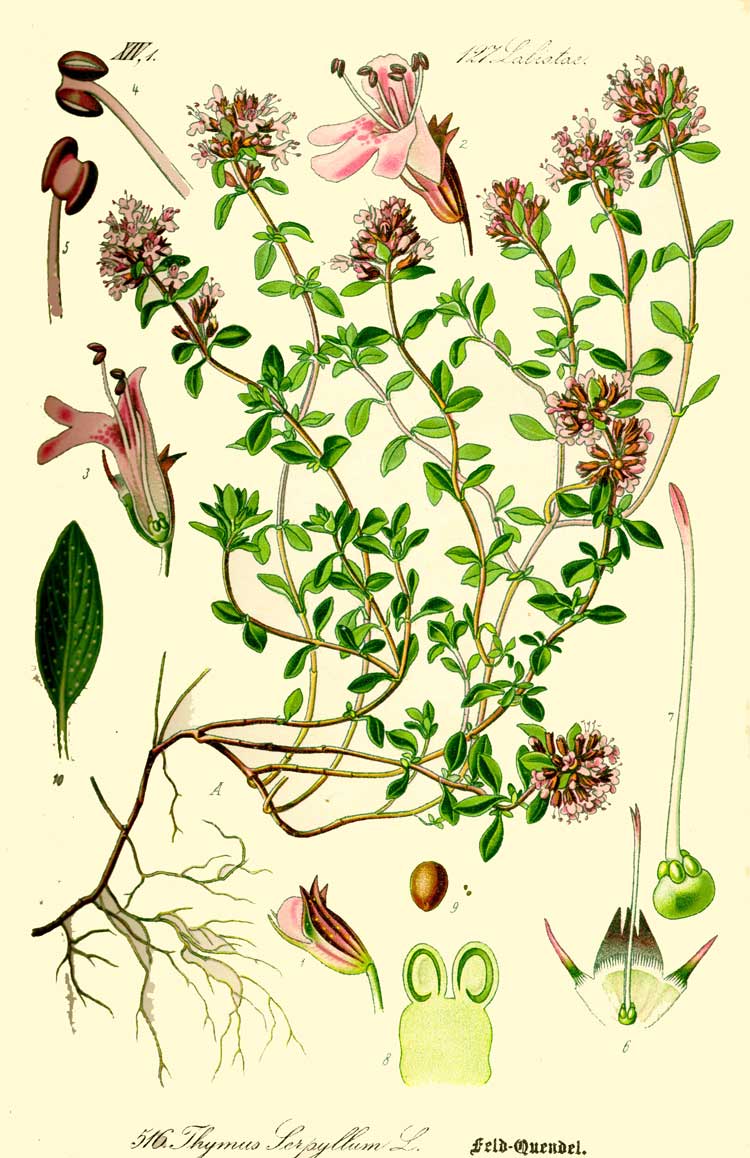
Thymus serpyllum (*)
Classification System: APG IV
Superregnum: Eukaryota
Regnum: Plantae
Cladus: Angiosperms
Cladus: Eudicots
Cladus: Core eudicots
Cladus: Asterids
Cladus: Lamiids
Ordo: Lamiales
Familia: Lamiaceae
Subfamilia: Nepetoideae
Tribus: Mentheae
Subtribus: Menthinae
Genus: Thymus
Sectio: T. sect. Serpyllum
Subsectio: T. subsect. Serpyllum
Species: Thymus serpyllum
Subspecies: T. s. subsp. serpyllum – T. s. subsp. tanaensis
Name
Thymus serpyllum L., Sp. Pl. 1: 590. (1753).
Type: Ind. loc.: "Habitat in Europae aridids apricis." Typus ignotus.
Synonyms
Homotypic
Thymus campestris Salisb., Prodr. Stirp. Chap. Allerton: 85 (1796), nom. superfl.
Serpyllum vulgare Fourr., Ann. Soc. Linn. Lyon, n.s., 17: 133 (1869).
Origanum serpyllum (L.) Kuntze, Revis. Gen. Pl. 2: 528 (1891).
Heterotypic
Thymus serpyllum var. canescens C.A.Mey. in A.T.von Middendorff, Reise Sibir. 1(2; 3): 72 (1856).
References
Komarov, V.L. et al. (eds.). 1934–1964. Flora SSSR. 30 vols. Moscow/Leningrad: Botanicheskii institut, Izdatel'stvo Akademii Nauk SSSR. Reference page.
Hassler, M. 2019. Thymus serpyllum. World Plants: Synonymic Checklists of the Vascular Plants of the World In: Roskovh, Y., Abucay, L., Orrell, T., Nicolson, D., Bailly, N., Kirk, P., Bourgoin, T., DeWalt, R.E., Decock, W., De Wever, A., Nieukerken, E. van, Zarucchi, J. & Penev, L., eds. 2019. Species 2000 & ITIS Catalogue of Life. Published on the internet. Accessed: 2019 26 April. Reference page.
Govaerts, R. et al. 2019. Thymus serpyllum in World Checklist of Selected Plant Families. The Board of Trustees of the Royal Botanic Gardens, Kew. Published on the internet. Accessed: 2019 April 26. Reference page.
International Plant Names Index. 2019. Thymus serpyllum. Published online. Accessed: 26 April 2019.
Vernacular names
العربية: زعتر بري
azərbaycanca: Sürünən kəklikotu
башҡортса: Кейәү үләне
български: дива мащерка
brezhoneg: Tin-lann, Munudig
bosanski: Majčina dušica
català: Serpoll, Farigola de muntanya, Farigola mascle, Frigoleta, Salsa de pastor, Serpol, Timó, Timó negre
čeština: mateřídouška úzkolistá
Cymraeg: Teim Breckland
dansk: Smalbladet Timian
Deutsch: Wilder Thymian, Sand-Thymian, Gundelkraut, Sandthymian, Feldkümmel, Feldquendel
dolnoserbski: Pěskowy płonjak
English: breckland thyme, wild thyme, creeping thyme
español: serpol, tomillo salsero, tomillo sanjuanero
eesti: Nõmm-liivatee, Kaetisrohi, Jaanitee, Nõmmeliivatee, Rabanduserohi, Mehitsehein
فارسی: سوسنبر
suomi: Kangasajuruoho
français: Serpolet, Thym serpolet
hrvatski: Majčina dušica
hornjoserbsce: Pěskowa babyduška, Płónc, Kulowske zelo, Pólna babyduška
magyar: Mezei kakukkfű, keskenylevelű kakukkfű, vadkakukkfű
Ido: Serpolo
italiano: Serpillo
ქართული: მხოხავი ბეგქონდარა
lietuvių: Paprastasis čiobrelis, Thymus vulgaris
latviešu: Mazais mārsils
Nederlands: Kleine tijm, Wilde tijm
occitan: Menudet, Serpol, Serpoulet
polski: Macierzanka piaskowa
Piemontèis: Thymus serpillum
română: Cimbrișor, Cimbrişor
русский: Богородская трава, Богородицына травка, Тимьян ползучий, Чабрец обыкновенный
davvisámegiella: Deanutimjan
srpskohrvatski / српскохрватски: Majčina dušica
slovenčina: dúška materina, materina dúška úzkolistá, dúška úzkolistá
српски / srpski: Мајчина душица / Majčina dušica, Тимијан / Timijan, Врисак / Vrisak, Дивљи босиљак / Divlji bosiljak
svenska: Backtimjan
українська: Чебрець звичайний
vèneto: Timo
walon: Såvaedje pilé
中文: 鋪地百里香, 野百里香, 鋪地香, 匍匐百里香
Thymus serpyllum, known by the common names of Breckland thyme,[3] Breckland wild thyme, wild thyme, creeping thyme, or elfin thyme, is a species of flowering plant in the mint family Lamiaceae, native to most of Europe and North Africa. It is a low, usually prostrate subshrub growing to 2 cm (1 in) tall with creeping stems up to 10 cm (4 in) long. The oval evergreen leaves are 3–8 mm long. The strongly scented flowers are either lilac, pink-purple, magenta, or a rare white, all 4–6 mm long and produced in clusters. The hardy plant tolerates some pedestrian traffic and produces odors ranging from heavily herbal to lightly lemon, depending on the variety.
Description
Wild thyme is a creeping dwarf evergreen shrub with woody stems and a taproot. It forms matlike plants that root from the nodes of the squarish, limp stems. The leaves are in opposite pairs, nearly stalkless, with linear elliptic round-tipped blades and untoothed margins. The plant sends up erect flowering shoots in summer. The usually pink or mauve flowers have a tube-like calyx and an irregular straight-tubed, hairy corolla. The upper petal is notched and the lower one is larger than the two lateral petals and has three flattened lobes which form a lip. Each flower has four projecting stamens and two fused carpels. The fruit is a dry, four-chambered schizocarp.[4]
Distribution and habitat
Wild thyme is native to the Palearctic realm of Europe and Asia. It is a plant of thin soils and can be found growing on sandy-soiled heaths, rocky outcrops, hills, banks, roadsides and riverside sand banks. Wild thyme is one of the plants on which both the common blue butterfly and large blue butterfly larvae feed and it is also attractive to bees.[4][5]
Chemistry
The oils of T. serpyllum contain thymol, carvacrol, limonene, paracymene, gamma-terpinene and beta-caryophyllene.[6]
Cultivation
Creeping and mounding variants of T. serpyllum are used as border plants and ground cover around gardens and stone paths. It may also be used to replace a bluegrass lawn to xeriscape low to moderate foot traffic areas due to its tolerance for low water and poor soils.[7][8][9]
Numerous cultivars have been produced, of which 'Pink Chintz' has gained the Royal Horticultural Society's Award of Garden Merit.[10][11] A miniature creeping form is 'Elfin'.[12]
References
Linnaeus. Sp. Pl. 590 1753.
"The Plant List: A Working List of All Plant Species".
Schauer, Thomas (1978). A Field Guide to the Wild Flowers of Britain and Europe, Collins, London, p. 184. ISBN 0-00-219257-8.
"Breckland Thyme: Thymus serpyllum". NatureGate. Retrieved 13 December 2013.
Eva Penn-Smith, Caterpillar food plants (PDF)
Debaggio, Thomas; Tucker, Arthur O. (2009). The Encyclopedia of Herbs. ISBN 9781604691344. Retrieved 10 May 2021.
"Thyme, the Fragrant Ground Cover". Fine Gardening. 25 April 2014.
"Planting and Maintaining a Thyme Lawn". GardenGuides.
"What is Xeriscape Nothing More Than Seven Common Gasrdening Principals". Archived from the original on 15 May 2010. Retrieved 23 May 2010.
"RHS Plant Selector - Thymus serpyllum 'Pink Chintz'". RHS. Retrieved 5 March 2021.
"AGM Plants - Ornamental" (PDF). Royal Horticultural Society. July 2017. p. 102. Retrieved 23 December 2018.
"Elfin Thyme Care – How Do I Plant Elfin Thyme In The Garden". Gardening Know How.
Caterpillar food plants
Retrieved from "http://en.wikipedia.org/"
All text is available under the terms of the GNU Free Documentation License

